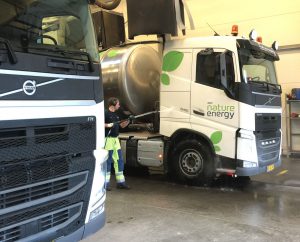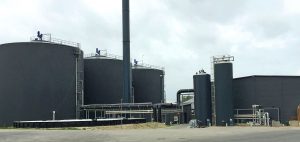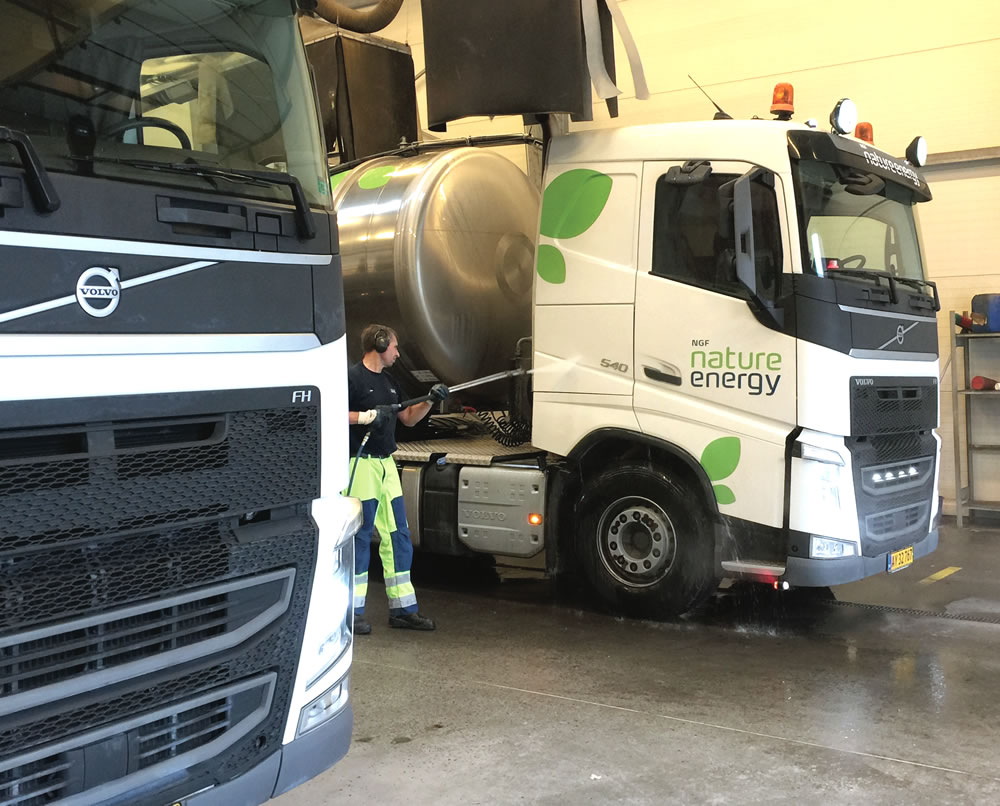A California Energy Commission policy advisor assesses applicability of Danish renewable gas infrastructure and economics to achieving the state’s greenhouse gas reduction goals.
Tim Olson
BioCycle February 2019

Trucks, each carrying 9,000 gallons of manure, connect to massive pumps and point source odor control equipment to offload into holding tanks. The trucks are cleaned and washed, then reloaded with liquid digestate. Photo courtesy of Tim Olson
The pastoral, green rolling hills of Denmark’s dairy, pig and livestock farms belie the development of a sophisticated industry imbedded in the region that converts waste residue to energy. On a cold, blue sky September day, we stood on the apron of the receiving facility in Ringe, Denmark and watched as a parade of trucks arrived, each containing 9,000 gallons of animal manure. The trucks connect to massive pumps and point source odor control equipment to offload the manure into holding tanks, then are cleaned and washed of seeds and residue, and reloaded with liquid digestate, an organic fertilizer, for delivery back to the farms where the manure originated. The entire offload and reload process takes 12 minutes per truck.
Located within 150 feet is a mechanized facility that receives and preprocesses food waste into a slurry, which is mixed with the manure to produce biogas in multiple digesters. Nearby, gas clean up technology columns convert the biogas into pipeline grade biomethane for injection 100 feet away into Denmark’s natural gas grid that also services northern Europe. Dozens of these new plants and expansions have been constructed throughout Denmark in six years. As a consequence, biomethane, also known as renewable gas, now represents 11 percent of Denmark’s gaseous fuel supply.
The Denmark biogas study tour in September 2018 increased our knowledge about the deployment of conversion technology, extracting waste residue from every aspect of daily life to produce useful energy sources. Denmark has maximized the potential to codigest mixed organic waste streams, improve logistics of transporting residue, build economy of scale biogas production plants and inject biomethane into the gas grid at half the cost for similar projects in the U.S. Danish and other European companies have also begun projects to integrate traditional anaerobic digesters (AD) with advanced power-to-gas technology, electrolyzing surplus wind power and accelerating a national strategy to decarbonize the natural gas system with the growth of renewable gas and also produce renewable hydrogen.
Denmark has excelled at capturing and converting methane when it reconfigured renewable energy policies and began working on renewable gas in 2012. This has been driven in part by dwindling fossil natural gas resources in the North Sea, which impacts Denmark and other countries in northern Europe. In turn, that has led to development of large-scale anaerobic digestion biogas plants to produce renewable gas. Denmark and other parts of Europe excel in all aspects of manufacturing supply chain technology components, designing, constructing and operating holistic biogas systems, and perfecting sustainable businesses practices — all contributing to reducing the costs of biomethane production and utilization.

The Nature Energy Midtfyn biogas plant is 150 feet away from a food waste pretreatment facility. Gas clean up technology equipment is 100 feet away from the injection point into the natural gas grid. Photo courtesy of Tim Olson
Lessons For California
The Danish experience demonstrates that methane recovery in a large number of projects can occur under the right circumstances. This is important because California has a lot at stake — a goal to reduce greenhouse gas emissions by 40 percent below 1990 levels by 2030, roughly a reduction of 170 million metric tons of carbon dioxide. Reduction of short-lived climate pollutants (methane being the prime source) has the potential to achieve 20 percent of this target. It means that the number of biogas projects operating in the state — currently 20 — that extract methane from dairies, landfills and wastewater treatment plants to produce electricity will need to increase to 500 to 1,000 projects to produce both power and transportation fuels. California’s potential sites include 1,300 dairies, 100 landfills and transfer stations, 385 food processing facilities and 400 wastewater treatment plants servicing the state’s 40 million people.
California’s initial growth is occurring with incentives to develop new AD projects at 42 dairies and explore alternative manure management methods for 40 additional livestock projects. A notable trend is dairy cluster projects developed by California Bioenergy, Calgren Renewables and Maas Energy to deliver biogas from several dairies and process it at central sites. Requirements to divert 75 percent of green waste and food waste from landfills by 2025 has spiked development of an initial group of AD projects at landfills and transfer stations to produce energy, including California’s first commercial scale gas pipeline injection at the CR&R facility in the city of Perris. Furthermore, wastewater treatment plants have begun development of digester projects in early market demonstrations at the Los Angeles County Sanitation District and City of San Mateo.
California is poised for significant growth of biogas use as an electricity source and transportation fuel with the potential to displace 5 to 15 percent of the state’s natural gas consumption. This has been spurred by the growing acceptance of anaerobic digesters in several applications, but primarily by state government funding incentives, pending regulations and reconfigured pipeline injection standards that create power and fuel use opportunities. The monetary value of Low Carbon Fuel Standard and Renewable Fuel Standard credits offer additional incentives for biomethane use as a transportation fuel.
A new policy is under development to establish minimum gas utility procurement requirements for renewable gas sources as a percent of the gas grid supply. This policy, when fully formulated, is expected to trigger long term contracts attracting increased private investment in projects.
California’s challenge is to complete an unprecedented transition to achieve a significant environmental benefit at an affordable cost, which includes valuing the host sites as assets and helping enable developers to fulfill the objective. Denmark’s success offers a learning experience and a number of insights to help us accomplish this outcome. We look forward to sharing our experience and engaging Danish partners in that journey.
Tim Olson is a senior policy advisor on transportation fuels and technology at the California Energy Commission (CEC). He currently leads the CEC’s strategic planning for emerging transportation fuels and technologies to develop alternative fuel growth scenarios, help manage an annual $100 million incentive fund, facilitate private investment in California projects, and conduct technology merit reviews.













